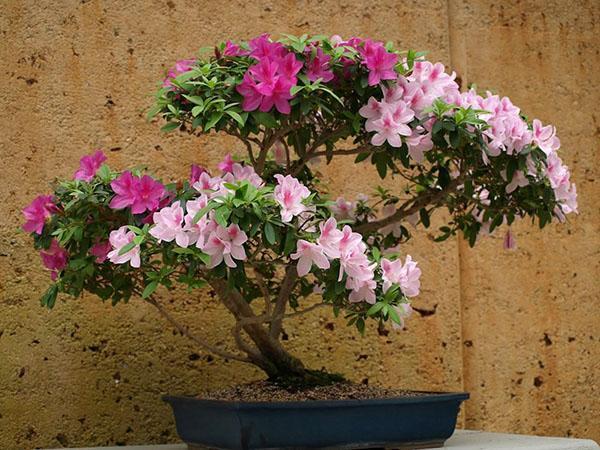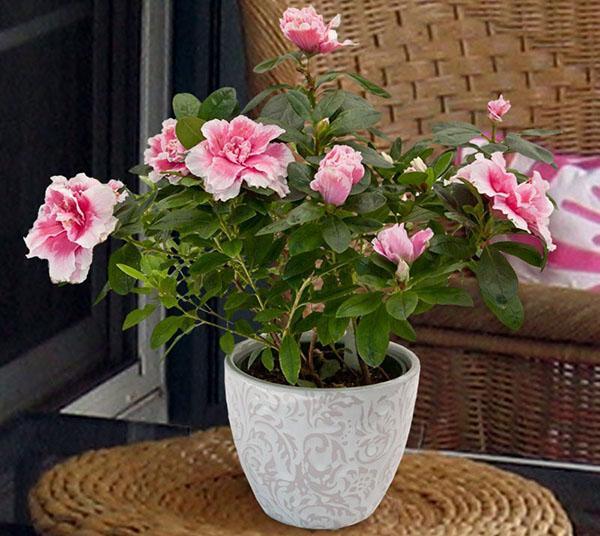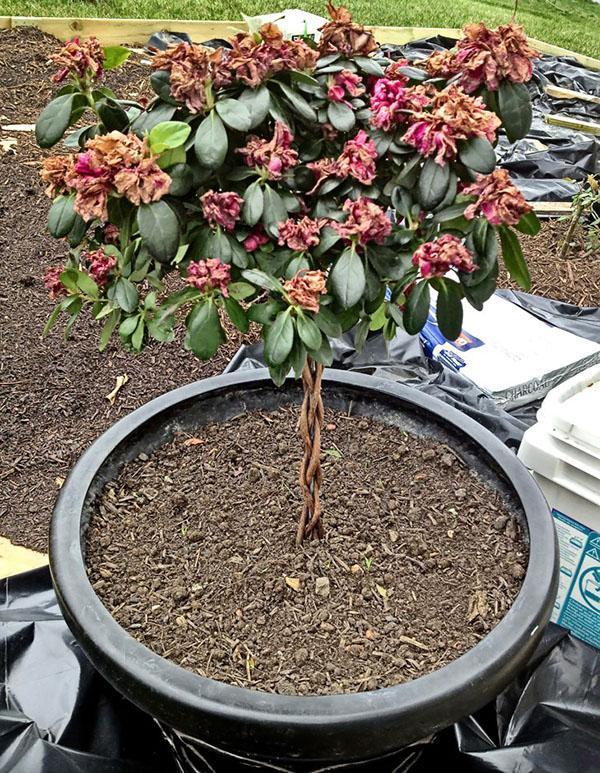Transplant and reproduction of azaleas at home
 Azaleas beautiful but capricious. In order for the plant to be healthy and bloom profusely, its owner will have to be patient, a lot of theoretical and practical skills, and also create comfortable conditions for living window sill decoration.
Azaleas beautiful but capricious. In order for the plant to be healthy and bloom profusely, its owner will have to be patient, a lot of theoretical and practical skills, and also create comfortable conditions for living window sill decoration.
Attention to the azalea flower is required from the first days of stay in the house. Often a bush brought from the store, covered with a lush cap of flowers, literally after a few days or weeks begins to wither, sheds flowers and foliage, and then dies. Some azaleas cannot recover from flowering and also dry up.
Faced with a similar situation, a novice florist blames himself or claims that azalea is a disposable flower and cannot be kept at home. This opinion is wrong! With proper preparation and diligence, the beautiful azaleas actively bloom, grow and even multiply.
Read also:azalea home care after purchase!
Azalea after purchase: risks and necessary measures

Nurseries producing domestic plants care little about the development of the root system and the further growth of the azalea. The shrubs, artificially brought to the flowering stage and planted in transport pots with a small amount of peat mixture, are additionally treated with retardants, synthetic substances that introduce the culture into a kind of sleep. Sustained-release fertilizers are added to the soil mixture, the supply of which maintains the freshness and flowering of the plant for 2–3 months. Roots, often damaged during transplantation, do not develop at this time. The plant is at risk for pests and fungal infections.
It is not surprising that moving from the store to the windowsill, the new pet weakens after a while and may die. The initial inspection of an azalea after purchase is aimed at identifying existing and developing problems and deciding on further actions:
- The peculiarity of azaleas is that a specific microflora is formed around the root system of the plant, the violation or removal of which threatens with problems for growing a crop.
- Excessive soil moisture is equally dangerous, leading to rotting of the small roots and root collar of the azalea.
 If, after buying from the azalea, problems with the root system are found, the condition of the soil is suspicious, there are traces of mold or salinity, it is better to transfer the plant to another container, removing damaged tissues and poor-quality soil.
If, after buying from the azalea, problems with the root system are found, the condition of the soil is suspicious, there are traces of mold or salinity, it is better to transfer the plant to another container, removing damaged tissues and poor-quality soil.
Do not transplant an azalea covered with flowers or buds. Transferring to another substrate will be a severe or irreparable stress for a culture that spends all its energy on many flowers.
If we are talking about saving a shrub, it is better to carefully remove most of the blossoming corollas and colored buds before transplanting.
It is dangerous to transplant an azalea in winter, when the plant is at rest, life processes, including restorative ones, are inhibited. It is better to try to wait for the renewal of vegetation and transfer the revived shrub to fresh soil.
Azalea transplant
 A regular transplant of azaleas is carried out when the mass flowering is completed.Such a measure will not only not damage the culture, but will also help to renew it, give it strength and lay the foundations for further growth.
A regular transplant of azaleas is carried out when the mass flowering is completed.Such a measure will not only not damage the culture, but will also help to renew it, give it strength and lay the foundations for further growth.
At the same time, the procedure carried out in relation to indoor rhododendrons has its own characteristics. First of all, you should be very careful about the root system of the shrub.
When the azalea is carefully removed from the pot, the grower most often finds a dense, black-brown sponge-like earthen ball. It is completely penetrated by many large and small roots, and traces of salts and dead tissue can be seen on the remaining fragments of soil. Therefore, the transplant of azaleas is always preceded by treatment, including:
- removal of the remnants of the old substrate;
- renewing root pruning;
- root processing growth stimulant and zircon.
All tools, whether it be a knife, pruner or scissors, with which the clod is trimmed, are pretreated with an alcohol-containing liquid or ignited over a burner.
Due to the excessive density of the root system inside the pot, the azalea loses some of its nutrients, the access of moisture and oxygen deteriorates. To remedy the situation, a lump with azalea roots is cut about a centimeter from the bottom, at the root collar and along the lateral surface. Along the way, soil residues are removed.
In this form, the azalea flower is placed in a container with clean warm water, into which, according to the instructions, a root system growth stimulator and zircon, which has an immunomodulatory and fungicidal effect, are added. During the time the florist prepares a nutritious soil mixture, the roots of the azalea are saturated with moisture, and stimulating drugs will show their effect.
 Unlike many houseplants, azaleas prefer to grow in acidic soil. Therefore, the mixture is specially prepared for them. To do this, take:
Unlike many houseplants, azaleas prefer to grow in acidic soil. Therefore, the mixture is specially prepared for them. To do this, take:
- specialized soil for azaleas;
- chopped steamed bark;
- sand;
- dried sphagnum moss;
- charcoal;
- perlite and vermiculite.
 The resulting mixture should be loose and airy. The pot for transplanting azaleas does not need a deep one, the main thing is that there is enough space for a powerful layer of drainage from small expanded clay and comfortable placement of the root system:
The resulting mixture should be loose and airy. The pot for transplanting azaleas does not need a deep one, the main thing is that there is enough space for a powerful layer of drainage from small expanded clay and comfortable placement of the root system:
- A small layer of substrate is poured onto expanded clay.
- An azalea flower is installed in the center of the container, around which fresh soil is gradually poured so that the root collar of the bush is not affected.
- The substrate is compacted and after transplanting, the azalea is lightly watered with a solution in which its root system has been soaked.
The best place for a shrub after the procedure is a well-lit window, but not in direct sunlight, where the plant is not threatened by drafts, and there are no heating devices nearby.
 In the following 3-4 days after transplanting the azaleas, the soil is not moistened, and then watering is gradually resumed using filtered or settled water at room temperature. Within 1-2 months, the plant must undergo acclimatization and replace the loss of the root system.
In the following 3-4 days after transplanting the azaleas, the soil is not moistened, and then watering is gradually resumed using filtered or settled water at room temperature. Within 1-2 months, the plant must undergo acclimatization and replace the loss of the root system.
Since the state of the azalea flower is still unstable, it is better not to feed it, and sometimes zircon is added to the irrigation water.
Reproduction of the azalea shrub by layering
 For propagation of azaleas at home, you can use layers rooted in the spring. For this:
For propagation of azaleas at home, you can use layers rooted in the spring. For this:
- shoots in the lower tiers of the bush are bent to the ground;
- with a sharp knife, a transverse cut is made on the wood, into which a match or a toothpick is put so that the cut does not join;
- the place of the incision is fixed with a wire hairpin to the loose substrate;
- the tip of the shoot is lifted so that it takes a vertical position, and secured with a peg.
The cuttings in the place of their attachment to the ground are sprinkled with a substrate and watered. It takes several months before the formation of the root system and the separation of the young azalea flower from the mother plant. This usually happens by the fall, and by the following spring the seedling will be ready to be transplanted into a separate pot.
Reproduction of azaleas by dividing the bush
In this way, you can propagate an azalea, which has many young shoots, the root system is developed and healthy. The procedure is carried out in spring, when the culture activates not only growth, but also defenses.
Propagation of azalea by dividing the bush is risky by damage to small, but extremely important roots for the plant. Therefore, the procedure should be carried out very carefully using a sharp disinfected knife.
The divided parts of the azalea, after transplanting into their own pots, restore strength for at least a year and require special attention and care.
Propagation of an azalea flower by cuttings
 As cuttings, take the apical parts of the shoots of the last year, 7–9 cm long and with several fully formed leaves. The cut is made obliquely with a sharp knife or blade. The bottom three leaves are removed, leaving a small portion of the cutting. All other leaf plates are shortened by half.
As cuttings, take the apical parts of the shoots of the last year, 7–9 cm long and with several fully formed leaves. The cut is made obliquely with a sharp knife or blade. The bottom three leaves are removed, leaving a small portion of the cutting. All other leaf plates are shortened by half.
To make the propagation of azaleas at home easier, before planting in the ground, the cuttings are immersed in a solution of a root system growth stimulator for a couple of centimeters. Such processing takes 4-6 hours.
Rooting of planting material is carried out in a loose substrate with an acid reaction. The cuttings are deepened by no more than 2 cm at a distance of 3-4 cm from each other. In a greenhouse and dim light, future plants will have to spend 1.5–2 months. The entire period of cuttings is necessary:
- contain at a temperature not lower than 25 ° C;
- water moderately;
- spray with warm, settled water;
- ventilate to prevent condensation and mold.
 To form a uniform crown, the planting container is turned from time to time. Azalea flower cuttings are removed from the greenhouse when their own shoots begin to form on them. Then young azaleas are transplanted into their own small pots and pinched, which will lay the foundation for the future crown of the plant.
To form a uniform crown, the planting container is turned from time to time. Azalea flower cuttings are removed from the greenhouse when their own shoots begin to form on them. Then young azaleas are transplanted into their own small pots and pinched, which will lay the foundation for the future crown of the plant.
After rooting and until an adult flowering plant is obtained, it takes 2 to 3 years. Since the azalea weakens noticeably after flowering, it is better to remove the first buds from young specimens.
Growing azaleas from seeds
 Getting blooming azaleas from seeds is extremely difficult and troublesome, but possible. For this, small seeds are mixed with dry sand and sown on the surface of the substrate. The best time for the procedure is spring.
Getting blooming azaleas from seeds is extremely difficult and troublesome, but possible. For this, small seeds are mixed with dry sand and sown on the surface of the substrate. The best time for the procedure is spring.
Future plants spend three weeks under the film at a temperature of 18-22 ° C and a constant humidity of 90-100%. They are regularly sprayed and ventilated to prevent drying out or mold. When true leaves are formed on the seedlings, it is time for azaleas to dive. And the seedlings that have reached a size of 10–12 cm are transplanted into their own pots.